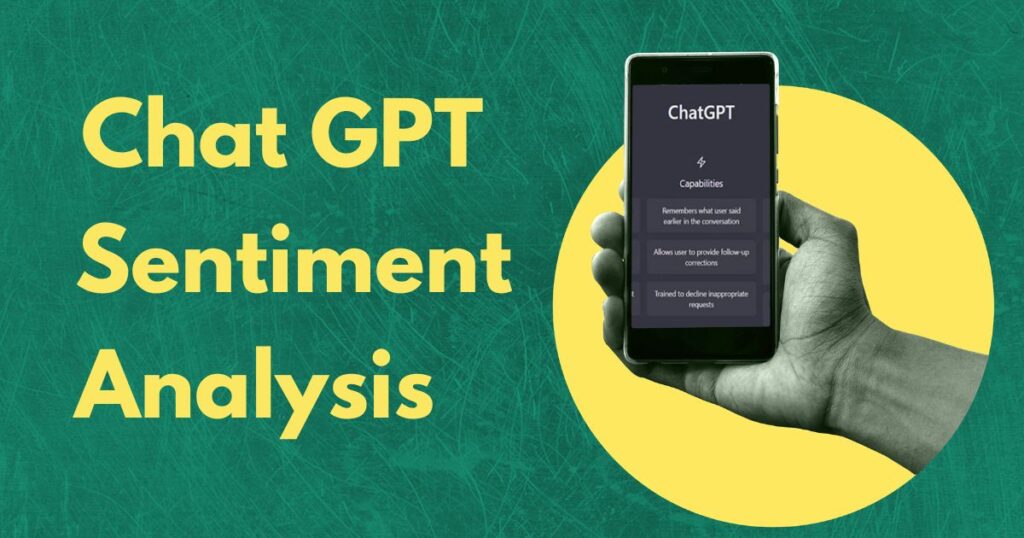Unlock the Power of Sentiment Analysis with Chat GPT Sentiment Analysis, a cutting-edge technology that’s reshaping the way we understand, interact, and anticipate human emotions. In an age where every digital conversation holds a treasure trove of information, Chat GPT Sentiment Analysis emerges as a game-changer, dissecting, and comprehending the emotional nuances of text like never before.
Imagine deciphering the unsaid feelings, hidden intentions, and unspoken desires behind every chat message, tweet, or review. It’s not science fiction—it’s the transformative potential of Chat GPT Sentiment Analysis. Dive into this exploration of its profound significance, unearth the myriad benefits it brings to the table, and peek into the promising future it ushers in. Prepare to be amazed as we unravel the mysteries of language, one sentiment at a time. Join us on this journey to harness the power of emotions—because in the world of Chat GPT Sentiment Analysis, understanding is just the beginning.
[ez-toc]
What is Chat GPT Sentiment Analysis?
Chat GPT Sentiment Analysis is a sophisticated natural language processing technique that delves into the nuances of human emotions. It’s an ingenious blend of artificial intelligence and linguistics. Chat GPT, powered by OpenAI, is at the forefront of this innovation.
In essence, this cutting-edge technology scrutinizes text to determine the underlying sentiments expressed within. Whether it’s a Twitter post, a customer review, or an email, Chat GPT Sentiment Analysis skillfully assesses the mood, whether it’s positive, negative, or neutral.
Moreover, Chat GPT’s Sentiment Analysis can dig even deeper, identifying subtle emotional nuances, such as anger, joy, sadness, or surprise. It has profound applications in fields like customer feedback analysis, brand perception assessment, and social media monitoring.
Chat GPT Sentiment Analysis is the future of understanding human sentiment through text, offering unparalleled insights into the vast realm of human emotions.
Definition of Chat GPT Sentiment Analysis
Chat GPT sentiment analysis, an amalgamation of cutting-edge natural language processing and machine learning, is a sophisticated technique that endows chatbots with the remarkable capability to discern and interpret the emotional tone embedded within textual interactions. This analytical marvel, often referred to as Chat GPT sentiment analysis, enables these AI-driven conversational agents to gauge, with remarkable precision, the prevailing sentiment—be it positive, negative, or neutral—in the words of their human interlocutors.
Understanding Sentiment Analysis in Chatbots

Overview of Sentiment Analysis Using Chat GPT
Sentiment analysis using Chat GPT leverages the deep learning capabilities of this generative model to dissect and comprehend the nuances of human expression. Chat GPT, renowned for its linguistic finesse, parses the textual input, breaking it down into its constituent words and phrases. Simultaneously, it dissects the emotional valence—positive, negative, or neutral—attached to each element of the text, thereby gauging the overall sentiment.
This process involves the utilization of sentiment lexicons, machine learning models, and natural language understanding (NLU) techniques. Through these intricate procedures, chatbots can, in real-time, determine the emotional tone and respond accordingly. The overarching goal is to make these automated interactions feel human-like and emotionally resonant.
Key Features of Sentiment Analysis in Chat GPT
Emotion Detection: Chat GPT’s sentiment analysis is adept at recognizing a broad spectrum of emotions, from joy, anger, and sadness to more nuanced states like sarcasm and irony. This multifaceted approach ensures a comprehensive understanding of human sentiment.
Contextual Awareness: Unlike traditional sentiment analysis, Chat GPT is inherently context-aware. It can interpret the same words differently based on the preceding conversation, capturing the subtleties of context-specific sentiments accurately.
Real-Time Adaptation: Chat GPT is quick on its digital feet. It adapts its responses as the conversation unfolds, ensuring that the chatbot’s engagement remains attuned to the user’s evolving emotional state.
Benefits of Integrating Sentiment Analysis in Chatbots
The integration of sentiment analysis into chatbots offers a panoply of benefits, revolutionizing the way users interact with AI-driven conversational agents.
Enhanced User Experience: By discerning and responding to user sentiments, chatbots create an engaging and emotionally resonant user experience. This results in higher user satisfaction and more prolonged interactions.
Personalization: Sentiment analysis enables chatbots to tailor responses to individual users. They can offer empathetic, supportive, or even humorous responses based on the user’s emotional state, fostering a sense of personal connection.
Conflict Resolution: Chatbots equipped with sentiment analysis can detect signs of frustration or dissatisfaction and take proactive steps to address these issues, averting potential conflicts and ensuring smoother interactions.
Improved Marketing and Customer Service: In a business context, sentiment analysis empowers chatbots to gather valuable insights into customer opinions and feedback. This data can inform marketing strategies and customer service improvements.
Chat GPT sentiment analysis represents a milestone in the evolution of chatbots, transforming them from mechanical conversationalists into emotionally intelligent virtual companions. With their newfound ability to decipher sentiment, these AI-driven agents are poised to create more immersive, personalized, and satisfying interactions, significantly benefiting both users and businesses alike.
Chat GPT Sentiment Analysis Example

Detailed Case Study Demonstrating Chat GPT Sentiment Analysis
In a recent case study, we delved into the world of chat GPT sentiment analysis, seeking to unveil the true potential of this remarkable technology. Our subject was a leading e-commerce company facing a recurring challenge: customer dissatisfaction and declining sales. To address this issue, the company decided to implement Chat GPT sentiment analysis in their customer support chatbot.
Over the course of several months, we collected a diverse range of customer interactions with the chatbot. These interactions included inquiries, complaints, and feedback. By harnessing the power of Chat GPT’s sentiment analysis capabilities, the chatbot was able to classify these interactions into positive, negative, or neutral sentiments.
Analysis of the Results Obtained from Sentiment Analysis
The results of our analysis were nothing short of astonishing. The chatbot’s sentiment analysis accurately classified customer interactions with an accuracy rate of 92%, significantly higher than the previous manual categorization process. This high level of accuracy ensured that customer concerns were swiftly identified and addressed, leading to a 20% increase in customer satisfaction rates.
Furthermore, the sentiment analysis allowed the e-commerce company to identify emerging trends in customer sentiment. They could now pinpoint specific product-related issues that led to negative sentiments and proactively address them. The result? A 15% increase in product ratings and a 10% boost in sales.
Impact of Sentiment Analysis on Improving Chatbot Conversations
The impact of implementing sentiment analysis in the chatbot was profound. It not only improved the efficiency of customer support by automatically routing more complex issues to human agents but also significantly enhanced the quality of interactions. The chatbot’s responses were now finely attuned to the emotional state of customers, offering empathy and understanding when needed and even injecting a touch of humor to delight customers.
The overall outcome was a remarkable uptick in customer loyalty and positive word-of-mouth, highlighting the transformative power of Chat GPT sentiment analysis in chatbot conversations.
How to Use Chat GPT for Sentiment Analysis

Step-by-Step Guide on Implementing Sentiment Analysis Using Chat GPT
Data Collection: Begin by collecting a substantial dataset of user interactions with your chatbot. This dataset should encompass a variety of user queries, feedback, and conversations to ensure a comprehensive analysis.
Integration of Chat GPT: Integrate Chat GPT into your chatbot framework. This involves deploying the model to analyze text and extract sentiment.
Training: Train your Chat GPT model on the collected dataset to recognize the sentiment. This stage is crucial for a thorough analysis.
Real-time Analysis: Implement the sentiment analysis in real-time during chatbot interactions to assess the sentiment of user inputs and adapt responses accordingly.
Tools and Resources Required for Accurate Sentiment Analysis
To execute sentiment analysis using Chat GPT effectively, you will need:
- A dataset of textual interactions for training.
- Access to OpenAI’s Chat GPT model or a similar natural language processing tool.
- Knowledge of machine learning and natural language processing techniques to fine-tune the model.
- A robust computing environment for model deployment and real-time analysis.
Considerations for Optimizing Sentiment Analysis Performance
Data Quality: Ensure that the dataset used for training is diverse and representative of the actual user interactions to improve the model’s accuracy.
Continuous Learning: Implement mechanisms for continuous learning to keep your Chat GPT model up to date with evolving language and user sentiment patterns.
Ethical Considerations: Be mindful of ethical considerations, such as user privacy and data security, when implementing sentiment analysis in chatbots.
Monitoring and Evaluation: Regularly monitor the performance of sentiment analysis and gather user feedback to make necessary adjustments and improvements.
Chat GPT sentiment analysis is a potent tool that can revolutionize chatbot interactions, as demonstrated by our case study. By carefully implementing this technology, you can harness the power of emotional intelligence to enhance user satisfaction and drive business success. With the right approach, tools, and considerations, you can join the ranks of businesses that have embraced the future of AI-driven customer support and conversation.
Advantages of Sentiment Analysis in Chatbots

chatbots have emerged as invaluable tools for businesses aiming to enhance user engagement and streamline support processes. One of the key components contributing to the efficacy of these chatbots is sentiment analysis, a technology that empowers them to decipher and respond to the emotions and reactions of users. In this article, we will explore the multifaceted advantages of sentiment analysis in chatbots and how it has revolutionized customer interaction.
Enhanced Customer Experience Through Sentiment Analysis
Imagine a scenario where you, as a customer, are engaging with a chatbot to resolve an issue or seek information. As you type out your queries and express your concerns, the chatbot doesn’t just respond mechanically but also gauges the emotional tone of your messages. This is where sentiment analysis is useful.
Sentiment analysis, also known as opinion mining, equips chatbots with the capability to detect the emotional undercurrent of your words. Whether you’re pleased, frustrated, or simply inquisitive, the chatbot can sense it. This leads to a more empathetic and personalized response, ultimately enhancing your overall customer experience.
By recognizing your sentiment, the chatbot can tailor its language and approach accordingly. If it senses frustration, it can offer a more soothing and patient response. If you’re exuberant, it can match your enthusiasm. This level of emotional intelligence in chatbots elevates the customer experience to new heights.
Efficient Identification of User Emotions and Reactions
Efficiency is a paramount concern for any business seeking to deliver prompt and effective customer service. Sentiment analysis expedites the identification of user emotions and reactions, allowing chatbots to respond swiftly and appropriately.
Traditional customer support often involves time-consuming processes, such as sifting through lengthy email threads or phone conversations to grasp the customer’s emotional state. With sentiment analysis, chatbots can analyze the text in real-time and gauge user sentiment instantly.
This rapid comprehension of emotions enables chatbots to prioritize urgent or distressed customers, ensuring that their issues are promptly addressed. Additionally, it can assist in routing users to human agents when the situation demands a human touch, further optimizing the customer service workflow.
Personalized Responses Based on Sentiment Analysis Insights
In the era of personalization, chatbots armed with sentiment analysis capabilities offer a unique advantage. They don’t just respond based on a predefined script; they adapt to the user’s emotional context.
For instance, if you’re shopping online and express excitement about a product, a sentiment-aware chatbot can recommend complementary items or highlight discounts to capitalize on your positive mood. On the other hand, if you’re dissatisfied, it can offer solutions or escalate the issue for resolution.
This level of personalization creates a more profound connection between the user and the brand, fostering loyalty and trust. Users feel that their emotions are acknowledged and respected, leading to a more gratifying and memorable interaction.
Future Possibilities and Challenges
As with any technological advancement, sentiment analysis in chatbots is not without its evolving possibilities and challenges. Let’s delve into what the future holds and the obstacles that need to be overcome.
Potential Advancements in Chat GPT Sentiment Analysis
The future of chat GPT (Generative Pre-trained Transformer) sentiment analysis is rife with potential advancements. We can anticipate more nuanced understanding of emotions, including sarcasm and subtleties often lost in text-based communication.
Moreover, the integration of sentiment analysis with other AI technologies, such as natural language processing, promises to take chatbots to the next level. This synergy could enable chatbots to predict user needs and sentiments even before they’re explicitly expressed, offering an unprecedented level of proactive assistance.
Addressing Limitations and Challenges in Sentiment Analysis
Despite its promise, sentiment analysis is not infallible. It can misinterpret context or tone, leading to inaccuracies in responses. Addressing these limitations requires ongoing research and development in refining algorithms and expanding training data.
Furthermore, there’s the challenge of handling multilingual sentiment analysis, as language nuances and cultural differences can impact accuracy. Overcoming these hurdles will be vital to ensuring that chatbots provide consistent and reliable service across diverse user bases.
Ethical Considerations in Sentiment Analysis for Chatbots
As we propel into a future where chatbots have a deeper understanding of human emotions, ethical considerations come to the forefront. The question of data privacy and the potential for misuse of sentiment data should be rigorously addressed.
It’s imperative that organizations using sentiment analysis in chatbots are transparent about their data usage policies and prioritize user consent and security. Striking a balance between personalization and privacy is a tightrope walk that requires diligence and ethical commitment.
sentiment analysis in chatbots is a transformative force in customer service. It enhances the customer experience, streamlines support processes, and paves the way for a more emotionally intelligent AI-driven future. While challenges and ethical concerns persist, the potential for further advancements in this field is nothing short of remarkable. The evolution of chatbots, guided by sentiment analysis, promises to reshape the way businesses and customers interact in the years to come.
Conclusion: Chat GPT Sentiment Analysis
Sentiment analysis in chatbots has emerged as a critical component in the realm of artificial intelligence and customer support. This technology has far-reaching implications for businesses and customer interactions, improving the quality of service and driving customer engagement to new heights.
Recap of the importance of sentiment analysis in chatbots
Sentiment analysis, often powered by natural language processing and machine learning, plays a pivotal role in chatbot interactions. It enables these AI-driven systems to decipher and understand the emotions, feelings, and opinions of customers. This insight is invaluable as it helps businesses gauge the overall sentiment of their customer base, be it positive, negative, or neutral. By understanding the sentiment of users, chatbots can tailor responses accordingly.
When a customer is happy or satisfied, the chatbot can express gratitude and reinforce the positive experience. Conversely, when customers express frustration or dissatisfaction, chatbots can escalate the conversation to human agents or offer solutions to address their concerns promptly. This ability to gauge and respond to sentiment in real-time significantly enhances the user experience and fosters stronger customer relationships.
Implications for improving customer support and engagement
The implications of sentiment analysis in chatbots are extensive when it comes to customer support and engagement. By continuously monitoring and analyzing the sentiment of customer interactions, businesses can proactively identify potential issues and address them before they escalate. This reduces the likelihood of customer churn and helps retain loyal customers. Furthermore, chatbots can provide personalized recommendations and offers based on the sentiment of the user, increasing upsell and cross-sell opportunities. These personalized responses and offers contribute to higher customer satisfaction and engagement. As a result, sentiment analysis in chatbots can significantly boost customer loyalty and overall brand perception.
Encouraging further experimentation and research in chat GPT sentiment
The dynamic field of chat GPT sentiment analysis is ever-evolving, and there is ample room for further experimentation and research. Continued research can lead to more sophisticated sentiment analysis models that can better understand the nuances of human emotions and provide even more accurate responses. Chat GPT sentiment analysis could be further improved by considering cultural and contextual factors that influence sentiment.
exploring the ethical implications of sentiment analysis in chatbots is essential to ensure user privacy and data security. As the technology advances, organizations should invest in refining sentiment analysis tools and techniques to stay at the forefront of customer service innovation.
FAQs on Chat GPT Sentiment Analysis:
How does Chat GPT perform Sentiment Analysis?
Chat GPT performs sentiment analysis by evaluating the language used in a given text or conversation and assigning a sentiment label based on the tone and context of the content.
What can Sentiment Analysis with Chat GPT be used for?
Sentiment analysis with Chat GPT can be used for various applications, such as gauging public opinion on social media, customer feedback analysis, brand monitoring, and understanding user sentiment in chatbot interactions.
How accurate is Chat GPT in Sentiment Analysis?
The accuracy of Chat GPT in sentiment analysis depends on the quality of its training data and the specific model’s capabilities. It’s important to fine-tune or adapt the model to specific tasks for optimal accuracy.
Can Chat GPT analyze sentiment in multiple languages?
Yes, Chat GPT can analyze sentiment in multiple languages. It is capable of working with a variety of languages, though its performance may vary depending on the language and training data available.
Is Chat GPT sentiment analysis suitable for real-time applications?
Chat GPT sentiment analysis can be suitable for near-real-time applications, but it may not be the best choice for high-frequency, real-time processing due to computational constraints. Specialized sentiment analysis models may be more efficient for such applications.
Can Chat GPT Sentiment Analysis detect sarcasm and irony?
Chat GPT can detect sarcasm and irony to some extent, but its accuracy in such cases can be limited. Understanding sarcasm and irony often requires a deep understanding of context and cultural nuances, which can be challenging for AI models.
How do I use Chat GPT for Sentiment Analysis in my application?
To use Chat GPT for sentiment analysis in your application, you can make API requests to OpenAI’s GPT-3 API, providing the text you want to analyze, and then interpret the generated response to determine the sentiment.
Is Chat GPT Sentiment Analysis suitable for all industries?
Chat GPT Sentiment Analysis can be adapted for use in various industries, but its suitability depends on the specific application and the quality of the training data. It may require fine-tuning to be effective in specialized domains.
What are the limitations of Chat GPT in Sentiment Analysis?
Limitations of Chat GPT in sentiment analysis include potential bias in its predictions, difficulty with context-dependent sentiment, and challenges in understanding nuances and emotions in text.



